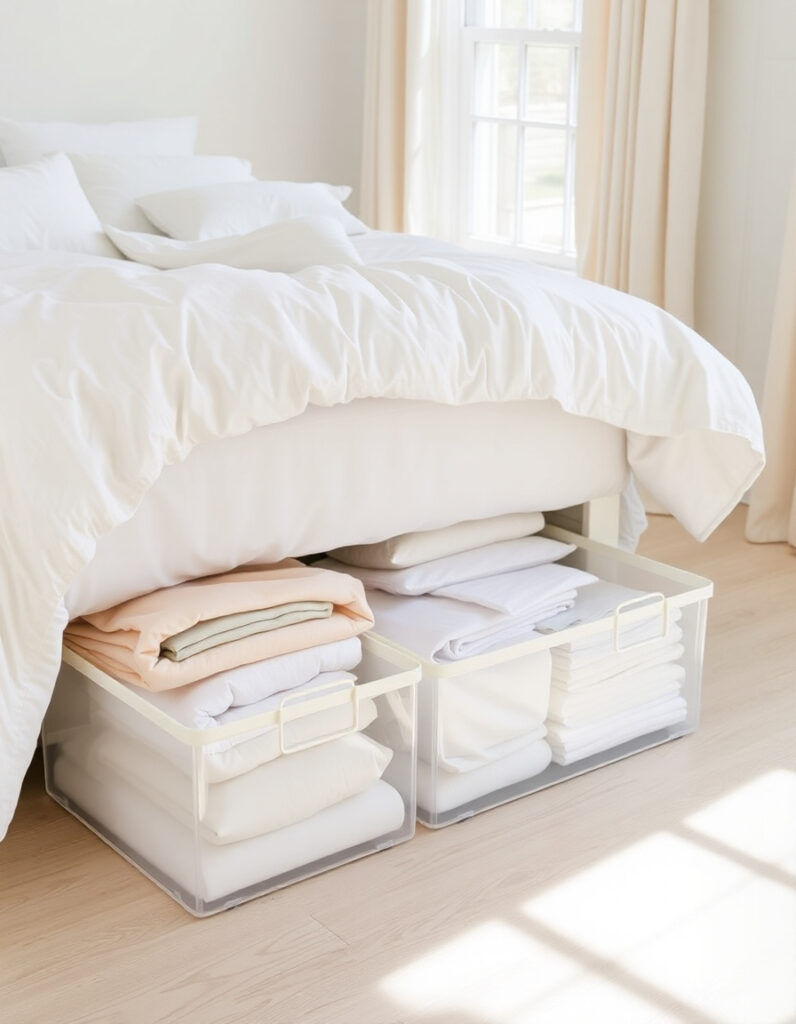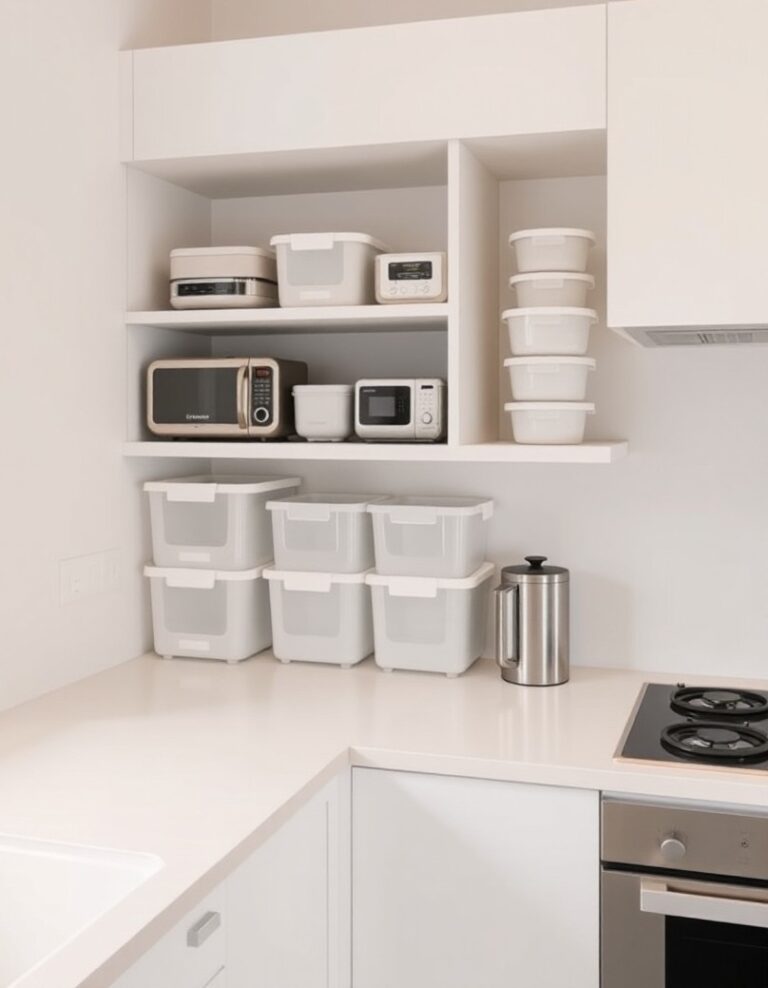Storing extra bedding without a linen closet can feel like a puzzle, especially in smaller homes or apartments. Bulky comforters, spare sheet sets, and seasonal blankets need a home that keeps them accessible without creating clutter. The good news is there are proven bedding storage ideas that work with any space layout.
Whether dealing with a studio apartment or just limited closet space, these bedding organization solutions will help keep linens tidy and easy to find. Let’s explore the smartest ways to organize bedding when traditional linen closet storage isn’t an option.
Why Bedding Storage Without A Linen Closet Matters

When there’s no dedicated space for storing sheets and blankets, bedding can quickly overtake bedroom floors, closets, or even living areas. Finding the right bedding storage solutions prevents clutter while keeping linens fresh and wrinkle-free.
Without proper organization, extra bedding gets shoved into random spots, making it hard to find matching sheet sets or seasonal blankets when needed. Smart storage keeps everything accessible and protects linens from dust and damage.
1. Store Extra Bedding Under The Bed With Rolling Bins
Under-bed storage is one of the most effective ways to store extra bedding in small spaces. Flat storage containers with wheels maximize unused space while keeping comforters and sheet sets hidden from view.
Choose bins with clear sides or label the ends to identify contents without pulling everything out. This method works especially well for storing seasonal bedding like heavy winter comforters during summer months.
Vacuum-seal bags can compress bulky bedding even further. Keep frequently used items in regular bins and save vacuum storage for off-season linens.
2. Use Decorative Baskets For Bedding Organization
Woven baskets and fabric storage bins blend into home decor while providing practical bedding storage solutions. Place them on open shelving, in bedroom corners, or under console tables to keep extra blankets and sheets contained.
Opt for baskets with handles for easy transport between rooms. Stack smaller baskets on closet shelves or use larger ones as standalone storage pieces.
Rolling bedding instead of folding makes it fit better in baskets. This technique also reduces wrinkles and makes grabbing what’s needed faster.
3. Repurpose Storage Ottomans And Benches For Blanket Storage
Multi-functional furniture is key when learning how to store bedding without a linen closet. Storage ottomans at the foot of the bed or benches in entryways provide seating while hiding folded blankets and extra pillows inside.
Look for pieces with removable lids or flip-top designs for easy access. These work perfectly for guest bedding and throw blankets that need frequent rotation.
Keep lighter-weight throws and everyday blankets in furniture storage. Reserve deeper storage areas for heavier seasonal bedding.
4. Hang Extra Bedding On Wall-Mounted Hooks And Racks
Wall hooks and mounted ladder racks turn vertical space into functional bedding storage. Sturdy hooks can hold folded blankets and quilts while adding visual interest to bedroom walls.
This bedding organization method works especially well for decorative throws or handmade quilts that complement room decor. Drape them over leaning ladder rungs or oversized wall hooks.
Position frequently used bedding at arm’s reach. Store seasonal items higher up where they’re less accessible but still organized neatly.
5. Maximize Closet Space With Hanging Organizers
Even without a linen closet, bedroom or hallway closets can accommodate extra bedding storage. Hanging shelf organizers create vertical storage without consuming valuable floor space.
Fabric cubes or shelf dividers prevent stacks from toppling over. Label each section to make swapping sheet sets quick and hassle-free.
Try the pillowcase folding method: fold complete sheet sets inside one matching pillowcase. This bedding storage hack keeps sets together and prevents linen chaos.
6. Compress Bulky Bedding With Vacuum Storage Bags
Vacuum-sealed bags are game-changers for storing bulky comforters and duvets. They compress bedding down to a fraction of its original size, perfect for seasonal items that won’t be accessed for months.
Slide these flat bags under beds, behind couches, or on top closet shelves. The airtight seal protects against dust, moisture, and musty odors.
Stick to vacuum-sealing synthetic-fill comforters and cotton blankets. Avoid compressing delicate fabrics like silk or natural down that could sustain damage.
7. Display Bedding On Open Shelving Units
Open shelves in closets, bedrooms, or hallways can showcase neatly folded linens. Use shelf dividers or storage baskets to keep stacks upright and create an organized appearance.
Arrange bedding by type, size, or color for visual cohesion. This organization method also makes spotting needed items effortless at a glance.
Store everyday sheets on lower, accessible shelves. Place guest bedding and seasonal blankets on higher shelves where they’re visible but out of the way.
8. Hide Bedding In Storage Trunks And Chests
A decorative trunk or storage chest at the bed’s foot adds character while concealing extra linens. Choose designs that complement existing decor so the piece feels intentional rather than utilitarian.
Line the interior with cedar blocks or lavender sachets to maintain freshness. This approach works well for bedding that won’t be rotated frequently.
Don’t overload storage trunks. Leave adequate space so lids close easily and bedding doesn’t become crushed or wrinkled.
9. Utilize Top Closet Shelves For Bedding Storage
The high shelf in bedroom or hallway closets offers prime real estate for storing extra bedding. Stackable bins or labeled boxes optimize this vertical storage space effectively.
Keep a step stool handy to access items stored up high. Reserve this area for guest bedding or seasonal comforters that don’t require frequent swapping.
Clear storage bins work best since contents are visible without removing everything. Add front-facing labels for even quicker identification.
10. Store Bedding In Nightstand And Dresser Drawers
When drawer space permits, dedicate one to extra pillowcases or lightweight throws. This keeps bedding storage close to where it’s used and frees up closet real estate for other items.
Roll linens instead of folding to maximize drawer capacity. This method works particularly well for flat sheets and duvet covers that don’t consume much space.
Keep only regularly used bedding in these high-traffic storage spots. Move backup sets and seasonal items to less accessible areas.
11. Install Over-Door Shelving For Small Space Bedding Storage
The space above doors is frequently overlooked for bedding organization. A shallow shelf installed here can hold folded blankets or sheet sets without intruding into room space.
This solution works best for lightweight bedding since over-door shelves have weight limitations. Use baskets or bins to contain items and maintain visual tidiness.
Ensure shelves are mounted securely to wall studs. Verify door clearance so opening and closing remains smooth.
12. Protect Delicate Bedding In Hanging Garment Bags
Hanging garment bags protect special linens from dust. They consume minimal closet rod space while keeping delicate fabrics in pristine condition.
Choose breathable fabric bags over plastic to prevent moisture buildup during long-term bedding storage. This is especially crucial for natural fibers.
Label the exterior of each bag clearly. Hang them toward the closet back where they won’t get disturbed by everyday clothing.
Common Bedding Storage Mistakes To Avoid
Skipping proper folding or rolling creates permanent creases in linens. Take extra time to fold neatly or roll tightly for better storage results.
Storing damp or musty bedding leads to mildew growth and unpleasant odors. Always wash and completely dry linens before putting them away.
Overstuffing storage containers compresses fabrics excessively and makes wrinkles harder to remove. Leave breathing room in bins and bags for best results.
Don’t store bedding in damp basements or hot attics without climate control. Extreme temperatures and humidity damage fabric fibers over time.
Expert Tips For Organizing Bedding Without A Linen Closet
Rotate stored bedding seasonally to prevent musty smells and keep fabrics fresh. Air out items every few months if they’ve been stored long-term.
Adopt the “one in, one out” rule when adding new bedding. This prevents accumulation and keeps storage manageable in small spaces.
Create an inventory list of stored bedding, especially for items in harder-to-reach spots. This saves time searching for specific sets.
Consider minimizing bedding collections to essentials: two sets per bed plus seasonal extras. Less bedding means easier storage and organization.
Frequently Asked Questions About Storing Bedding Without A Linen Closet
How do you keep stored bedding smelling fresh without a linen closet?
Add dryer sheets, cedar blocks, or lavender sachets to storage bins and containers. Air out bedding every 2-3 months if stored long-term. Wash linens before storing to prevent trapped odors from setting in.
What’s the best way to store extra bedding in a small apartment?
Focus on multi-functional furniture like storage ottomans, under-bed bins, and wall-mounted solutions. Vertical storage on walls or high shelves maximizes space without consuming floor area. Vacuum-seal bags work well for seasonal bedding.
Can you store bedding in plastic storage bins?
Yes, plastic bins work well for bedding storage. Choose containers with ventilation holes or crack lids occasionally to allow air circulation. Completely airtight containers can trap moisture and create musty smells over time.
How often should you rotate stored bedding?
Swap out seasonal bedding as weather changes, typically twice yearly. Guest bedding can remain stored until needed, but air it out 1-2 times per year to maintain freshness and prevent odors.
Should sheet sets be stored together or separately?
Store complete sheet sets together for easier bed-making. Fold everything into one matching pillowcase to keep fitted sheets, flat sheets, and pillowcases paired. This bedding organization hack prevents mismatched sets.
Where should you store bedding if you don’t have closet space?
Use under-bed storage, furniture with hidden compartments, wall-mounted hooks, or decorative baskets on shelving. Over-door shelves and storage trunks also provide effective bedding storage without requiring closet space.
How do you store comforters without a linen closet?
Vacuum-seal bags compress comforters for under-bed storage. Storage ottomans, trunks, or large baskets also accommodate folded comforters. Roll instead of fold to reduce wrinkles and save space.
What’s the most space-efficient way to fold bedding for storage?
Rolling linens saves more space than traditional folding. For sheet sets, fold everything inside one pillowcase to keep sets together. Flat-folding works for open shelving displays.
Start Organizing Your Bedding Storage Today
Storing extra bedding without a linen closet is completely manageable with the right strategies. These 12 bedding storage solutions work for any space size and keep linens organized, accessible, and fresh. Pick the methods that fit the available space and start tackling bedding clutter today. With smart organization, even the smallest home can accommodate all the sheets, blankets, and comforters needed.



